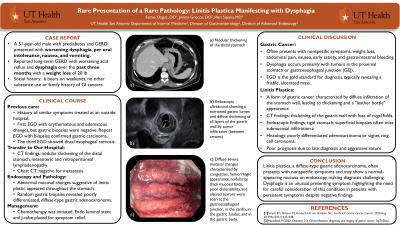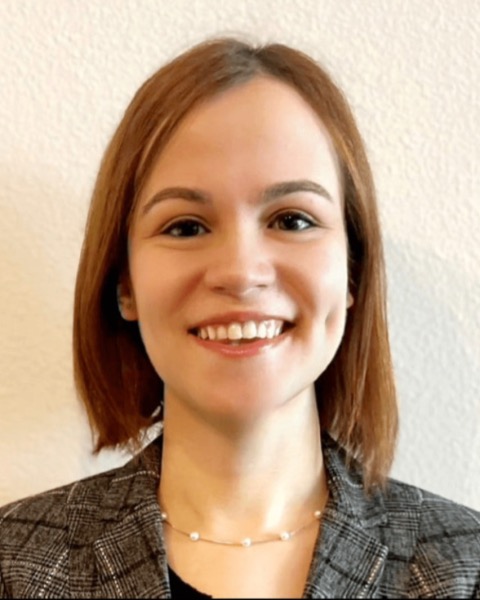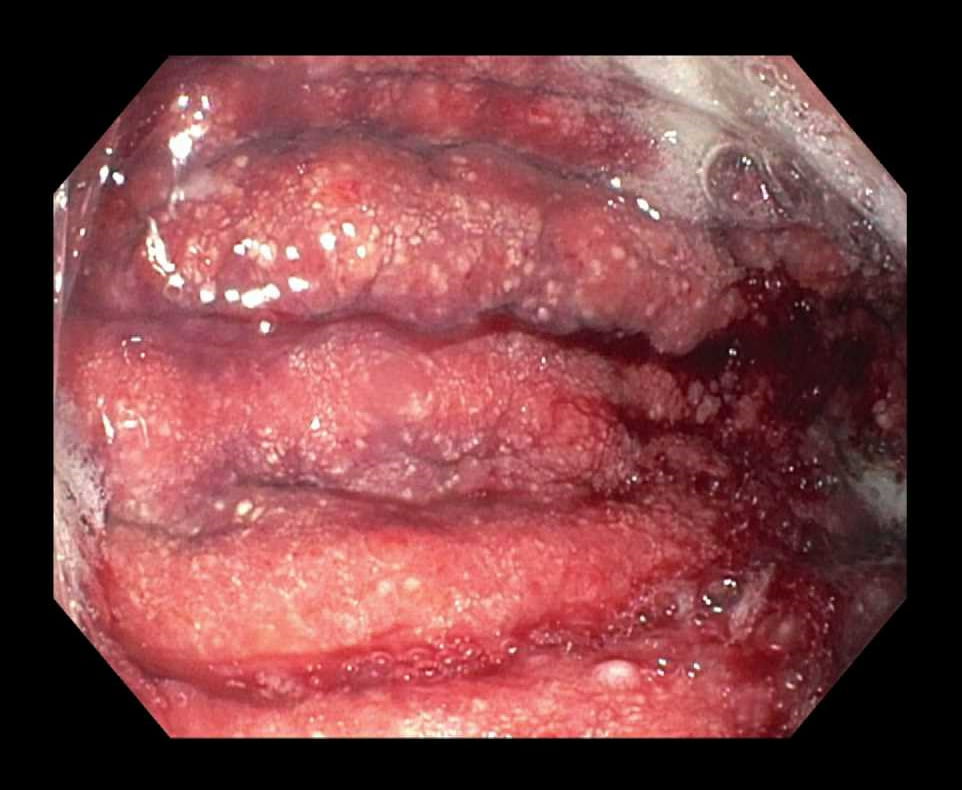Sunday Poster Session
Category: Stomach
P1670 - Rare Presentation of a Rare Pathology: Linitis Plastica Manifesting with Dysphagia
Sunday, October 27, 2024
3:30 PM - 7:00 PM ET
Location: Exhibit Hall E

Has Audio

Fatma Ozguc, DO
UTHSCSA
San Antonio, TX
Presenting Author(s)
Fatma Ozguc, DO1, Iqra Kazi, MD2, James Gnecco, DO1, Hari Sayana, MD3
1UTHSCSA, San Antonio, TX; 2University of Texas Health San Antonio, San Antonio, TX; 3University of Texas Health Science Center, San Antonio, TX
Introduction: Most patients with gastric cancer present with symptoms and have advanced disease at the time of diagnosis[1]. The most frequent symptoms are weight loss and abdominal pain[2]. Dysphagia is unusual as a presenting symptom except with tumors in the cardia or at the gastroesophageal junction (GEJ). In this report, we describe a rare presentation of linitis plastica manifesting with dysphagia.
Case Description/Methods: A 51-year-old male with prediabetes and GERD presented with worsening dysphagia, nausea, and vomiting. He drinks 6 beers on weekends and has no other substance use or family history of gastrointestinal cancers. He previously sought care at an outside hospital for similar symptoms, reporting long-term GERD with worsening acid reflux and dysphagia over the past three months accompanied by 20-pound weight loss. Initial EGD showed prominent erythema and thickening at the GEJ and gastric body. However, gastric biopsies did not reveal any dysplasia or malignancy, while esophageal biopsies indicated gastric carcinoma. The patient was transferred to our hospital for higher level of care, where CT scan showed nodular thickening of the distal stomach with mesenteric and retroperitoneal lymphadenopathy. CT chest was negative for metastatic disease. An EUS revealed congested, hemorrhagic, nodular, and texture-changed mucosa in the GEJ, cardia, gastric fundus, and body, suggesting linitis plastica. Repeat bite-on-bite gastric biopsies confirmed poorly differentiated/diffuse-type gastric adenocarcinoma. Given the lymphadenopathy and locally advanced disease, the patient began chemotherapy and received palliative esophageal stenting and J-tube placement.
Discussion: Upper Endoscopy is the gold standard for tissue diagnosis and localization of gastric tumors. Gastic cancer typically presents as a friable, ulcerated mass, which can result in abdominal pain, poor appetite and early satiety [2]. However, in patients with linitis plastica, the gastric mucosa may appear normal, which in turn can result in a missed diagnosis [1]. Dysphagia is an atypical presentation for this rare subset of gastric cancer, but a thorough endoscopic examination can help make the diagnosis.
[1] Mansfield, P. (2022, October 21). Clinical features, diagnosis, and staging of gastric cancer. UpToDate.
[2] Smyth EC, Nilsson M, Grabsch HI, van Grieken NC, Lordick F. Gastric cancer. Lancet. 2020 Aug 29;396(10251):635-648.

Disclosures:
Fatma Ozguc, DO1, Iqra Kazi, MD2, James Gnecco, DO1, Hari Sayana, MD3. P1670 - Rare Presentation of a Rare Pathology: Linitis Plastica Manifesting with Dysphagia, ACG 2024 Annual Scientific Meeting Abstracts. Philadelphia, PA: American College of Gastroenterology.
1UTHSCSA, San Antonio, TX; 2University of Texas Health San Antonio, San Antonio, TX; 3University of Texas Health Science Center, San Antonio, TX
Introduction: Most patients with gastric cancer present with symptoms and have advanced disease at the time of diagnosis[1]. The most frequent symptoms are weight loss and abdominal pain[2]. Dysphagia is unusual as a presenting symptom except with tumors in the cardia or at the gastroesophageal junction (GEJ). In this report, we describe a rare presentation of linitis plastica manifesting with dysphagia.
Case Description/Methods: A 51-year-old male with prediabetes and GERD presented with worsening dysphagia, nausea, and vomiting. He drinks 6 beers on weekends and has no other substance use or family history of gastrointestinal cancers. He previously sought care at an outside hospital for similar symptoms, reporting long-term GERD with worsening acid reflux and dysphagia over the past three months accompanied by 20-pound weight loss. Initial EGD showed prominent erythema and thickening at the GEJ and gastric body. However, gastric biopsies did not reveal any dysplasia or malignancy, while esophageal biopsies indicated gastric carcinoma. The patient was transferred to our hospital for higher level of care, where CT scan showed nodular thickening of the distal stomach with mesenteric and retroperitoneal lymphadenopathy. CT chest was negative for metastatic disease. An EUS revealed congested, hemorrhagic, nodular, and texture-changed mucosa in the GEJ, cardia, gastric fundus, and body, suggesting linitis plastica. Repeat bite-on-bite gastric biopsies confirmed poorly differentiated/diffuse-type gastric adenocarcinoma. Given the lymphadenopathy and locally advanced disease, the patient began chemotherapy and received palliative esophageal stenting and J-tube placement.
Discussion: Upper Endoscopy is the gold standard for tissue diagnosis and localization of gastric tumors. Gastic cancer typically presents as a friable, ulcerated mass, which can result in abdominal pain, poor appetite and early satiety [2]. However, in patients with linitis plastica, the gastric mucosa may appear normal, which in turn can result in a missed diagnosis [1]. Dysphagia is an atypical presentation for this rare subset of gastric cancer, but a thorough endoscopic examination can help make the diagnosis.
[1] Mansfield, P. (2022, October 21). Clinical features, diagnosis, and staging of gastric cancer. UpToDate.
[2] Smyth EC, Nilsson M, Grabsch HI, van Grieken NC, Lordick F. Gastric cancer. Lancet. 2020 Aug 29;396(10251):635-648.

Figure: Endoscopic findings of diffuse severe mucosal changes characterized by congestion, hemorrhagic appearance, nodularity, thick mucosal folds, poor dispensability, and altered texture were seen at the gastroesophageal junction, in the cardia, in the gastric fundus, and in the gastric body.
Disclosures:
Fatma Ozguc indicated no relevant financial relationships.
Iqra Kazi indicated no relevant financial relationships.
James Gnecco indicated no relevant financial relationships.
Hari Sayana indicated no relevant financial relationships.
Fatma Ozguc, DO1, Iqra Kazi, MD2, James Gnecco, DO1, Hari Sayana, MD3. P1670 - Rare Presentation of a Rare Pathology: Linitis Plastica Manifesting with Dysphagia, ACG 2024 Annual Scientific Meeting Abstracts. Philadelphia, PA: American College of Gastroenterology.
